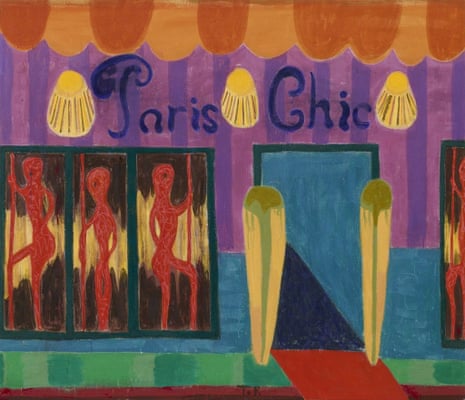A court in Denmark will rule on Monday on whether to prohibit a pair of Faroese art provocateurs from destroying a painting by the Danish artist Tal R and using pieces of the canvas as decorative faces for a line of luxury wristwatches.
Dann Thorleifsson and Arne Leivsgard, who five years ago founded the Kanske watch brand, bought Paris Chic, one of Tal R’s brightly coloured Sexshops series, for £70,000 at the Victoria Miro gallery in London in August.
In October, they revealed plans to use the canvas as raw material to manufacture between 200 and 300 watches for Letho, their new brand, which they aim to sell for 10,000 Danish kroner (£1,150) each.
“We needed an artist that was esteemed by experts because we also needed to get a reaction,” Thorleifsson said. “If we just took a $100 canvas, no one would really care. It needed to be a true masterpiece.”
The duo, who also together run a Copenhagen design studio, have purchased paintings by three other recognised Danish artists, John Kørner, David Birkemose and Jens Birkemose, helped by funding from an unnamed patron.
Tal R in October dismissed the project in an email to the Politiken newspaper, as a “disrespectful” attempt “to make money and get attention by making a product out of my art”.
His lawyer, Jørgen Permin, argued in a one-day hearing at the maritime and commercial court in Copenhagen in November that the scheme was a clear case of copyright infringement.
“He acknowledges that whoever purchases one of his works would be at liberty to sell it on or even destroy the work,” Permin said. “But what he is not obliged to accept is for someone to alter the work and then reintroduce it to the public domain, and particularly not for commercial reasons.”
Heidi Højmark Helveg, who represented Thorleifsson and Leivsgard, argued that as the project involved destroying rather than altering the work, it was legal under Danish law.
“The pieces will be so small that it will not possible to know in any way which work it is from,” she said. “Each watch will take just 0.04% of the original work.”
Permin said this argument failed because the watches would be marketed “specifically as having Tal R’s painting as background”.
If the court imposes an injunction, Tal R would then need to launch a further case to confirm it. If the court instead refuses a ban, Thorleifsson and Leivsgard plan in a fortnight to destroy the painting at a public event they are calling a vernissage, a term more commonly used for a preview of an art exhibition.
While the pair’s now discontinued Kanske brand had been a commercial venture, Thorleifsson said that the Letho project had from the start been intended to test the boundaries of art.
“It’s not a commercial project, but we don’t know if it is an artistic project. That has to be determined by others,” he said.
Permin said that as far as his client was concerned, it was not. “He thinks it is a very destructive thing for art, and he doesn’t subscribe to the idea that tearing up his art in this manner would be art itself,” Permin said. “He really wishes this had never happened.”
